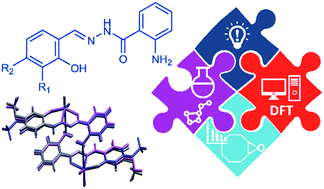The focus of this work was on the synthesis, characterization and catalytic activity of Mo(VI) complexes with hemilabile polydentate ligands that show a high tendency to form discrete small-sized self-assembled structures. A series of mononuclear, [MoO2(L1 or 3)(MeOH)] (1a and 3a) and [MoO2(L1)(EtOH)] (1b), and dinuclear, [MoO2(L1–3)]2 (1–3), complexes was synthesised by using 2-aminobenzoylhydrazone ligands derived from salicylaldehyde (H2L1), 3-methoxy-2-hydroxybenzaldehyde (H2L2) and 4-methoxy-2-hydroxybenzaldehyde (H2L3). Different reaction conditions led to the formation of several crystalline forms of the dinuclear cyclic species [MoO2(L1 or 3)]2 (1-α, 1-β, 1-γ, 1·CH3CN, 3-α, 3-β and 3·2CH3CN), a feature which is observed for the first time in the case of the metallosupramolecular compounds incorporating cis-MoO22+ subunits. These complexes were tested as catalysts for cyclooctene epoxidation under eco-friendly reaction conditions by using aqueous tert-butyl hydroperoxide as an oxidant without the addition of an organic solvent. The use of the hemilabile ligands provided the opportunity to employ relatively stable coordinatively saturated dinuclear Mo(VI) complexes, which in turn offered access to highly reactive pentacoordinated species in the presence of olefins. Lastly, the hemilabile ligand induced catalytic enhancement was addressed by using density functional theory calculations.

